22 Helpful Desert Hiking Tips to Know

Desert hiking can seem daunting. However, desert hiking can be a hugely rewarding and romantic place to go for a hike. The colors of the desert and their landscapes at times feel like another planet and the stuff dreams are made of. A hike in the desert displays the extremes of our planet and their geological features at times appear to defy gravity.
While deserts themselves may be easy to lump into one general biome their diversity is amazing. We’ve been hiking in places like the Sahara, Wadi Rum, Canyonlands, Saguaro, and the Namib Desert and each looked nothing like the other. Outside of the fact they all receive little to no precipitation, they share few things in common.
We just finished up several weeks hiking in the desert. With the release of Stanley’s new Iceflow Hydration line, we went to the hottest place we could find to test out how they handle the desert heat. After, finishing up another successful hiking trip in the desert we figured it was time to share our top tips.
Our Top Desert Hiking Tips!
Avoid The Middle of The Day
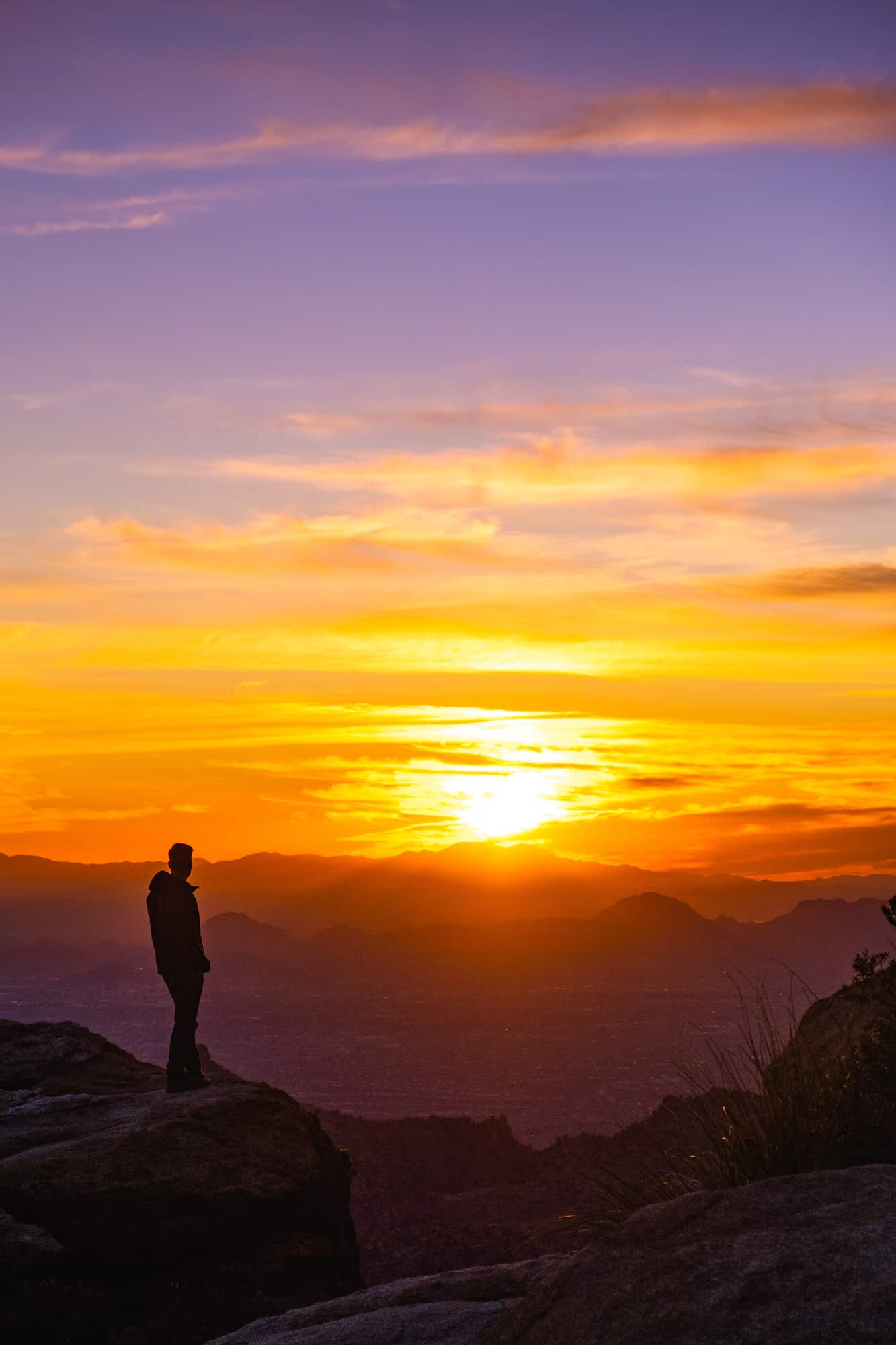
When it comes to hiking in the desert, you want to begin your days early and end late, something we took seriously when hiking to Delicate Arch in Arches National Park. We’ll start off the day with an early rise. Once at the trailhead, we’ll make some coffee with our Stanley Perfect Brew Pour-Over Set. If you’re really an early bird, you’ll get to enjoy the sunrise over the desert, which is one of the most magical experiences.
Even if you’re not at the trailhead for sunrise, an early start is best in order to avoid the peak heat and sun in the middle of the day. We’ll try to time our day to take a siesta in the middle of the day to avoid the heat. This can either be out on the trail in a slot canyon, hiking during the spring, or heading back to town for some downtime.
Once temperatures start to settle back down, hiking in the evening can be pleasant again. Consider taking a sunset hike as we did on the Watchman Trail to watch the sunset over the desert and the stars come out at night. Just be sure to pack a flashlight or headlamp for your way out.
On top of just the pleasantness, when hiking outside in the middle of the day, you’ll notice your photos will be a lot better too. Photos of the desert in the middle of the day look void and lack any color with hard shadows. So if you care about your photography, the best time to shoot is before 9 am and after 4 pm.
Stay Hydrated

This was super important when we hiked Angels Landing in Zion. Maintaining your hydration while in a desert hiking environment is critical. It doesn’t start on the trail either, as you should be mindful about your water consumption pre and post-hike. Ideally, you should consume a liter of water before the hike and 3 liters throughout the day. Yes, that means you’ll need to consume 4L to a gallon of water.
It may seem like a lot of water, but deserts are notorious for their ability to dehydrate hikers. A common mistake many hikers make is only drinking when thirsty. Water should be consumed throughout the day regardless of your thirst.
Keep Cool With Cold Water and Electrolytes



To help combat the heat, carry an insulated water bottle and a bladder with extra water. The Stanley Iceflow Hydration Bottle is great as it can keep drinks ice cold forever. We put ice in our cup on Friday and still had cubes floating about on Monday!
Ice cold water can actually help regulate your body too. It’s best to sip cold water throughout the day as it’s not as effective at hydrating you as room temperature water.
For a cold, drink try mixing in electrolytes, and sipping throughout the day to stay replenished. Mix this in between regular water drinks. If you’re losing too many electrolytes in while desert hiking, you could be susceptible to hyponatremia or low sodium in the blood.
Plan & Carry Extra Water

Whatever your plans are for the day or your hike, bringing more than enough water is a good idea. On a day hike, it’s better to carry an extra liter of water for the day rather than run out of water in the desert heat. Water is crucial when hiking in desert environments and should always be on your mind.
Study your route in advance if on a backpacking trip, and be aware of all water sources along the route. Plan for the worst-case scenario since it’s possible for water sources to go foul or dry up along the route. Be mindful of conditions along the trail and the weather leading up to the hike, as it will provide clues to the water sources along the route.
Love Your Feet

Learn to practice good self-care with your feet when desert hiking and always! The most common affliction affecting less experienced hikers is blisters and hot spots. However, with some attention, it’s pretty easy to avoid these.
First, you’ll want quality hiking socks made from a material like wool. It’s best to avoid cotton as it traps moisture and, with movement, causes blisters. I like to buy socks that are at least ankle length (no no-show socks) so that I don’t get blisters on my heel. Next, you’ll want a comfortable pair of hiking shoes or boots that you’ve worn before the hike. I say before because it allows you the chance to find any issues that may arise.
While on the trail, especially in the desert, take your shoes off during breaks. This will give your feet, shoes, and socks a chance to dry. It’s also a good time to dump any sand or small rocks out of the shoes, which can also be troublesome. While resting, prop your feet up on your pack or rock to aid in the recovery of your lower body.
One last tip is to carry one or two blister pads in your first aid kit. Ideally, you’ll never need them, but when you do, they are lifesavers!
Protect Your Eyes
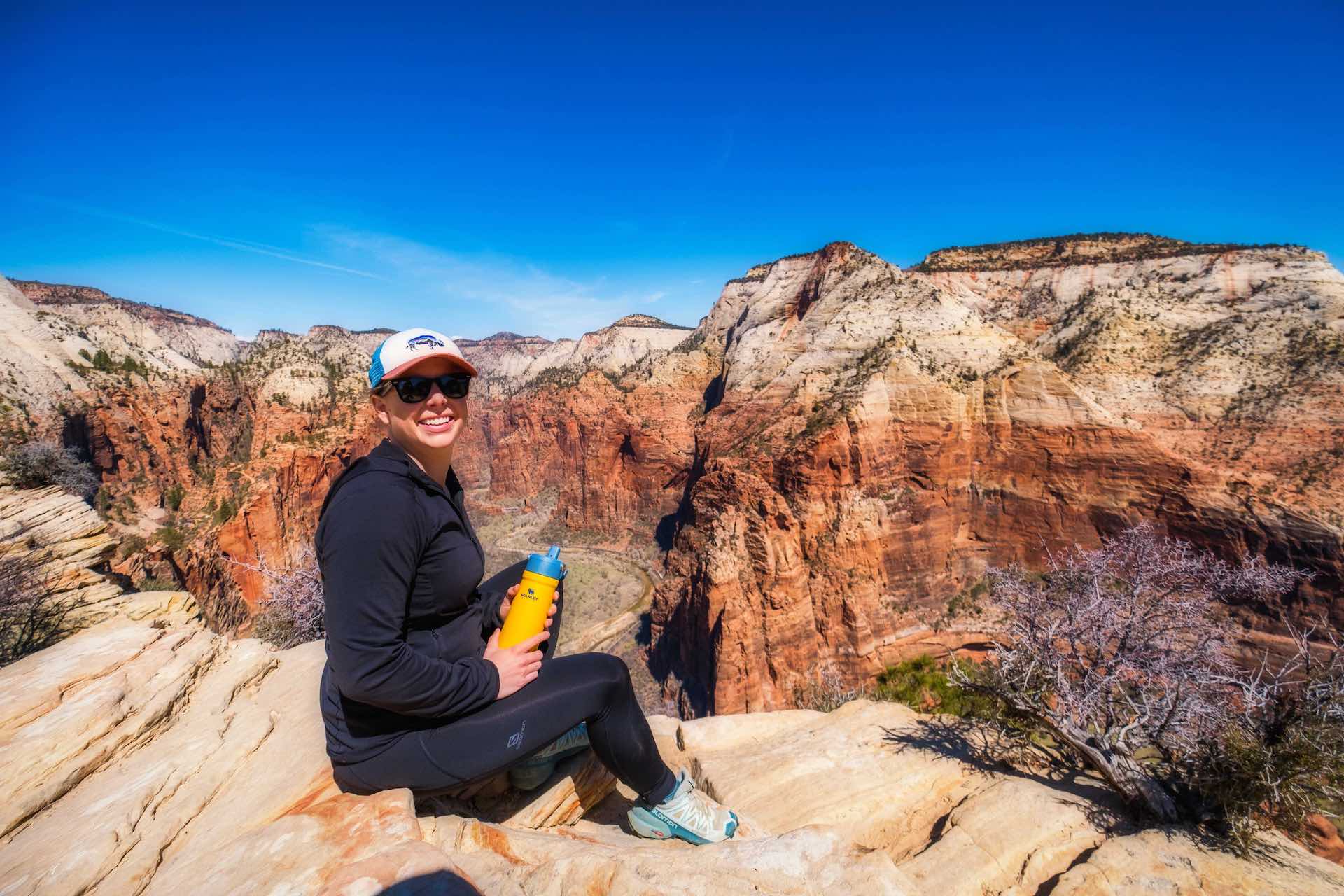
Deserts are very bright and dusty. These environments are extremely harmful to your eyes, which we learned the hard way while hiking in Zion. Not only can it cause long-term eye damage, but it can also cause irritation, headaches, and temporary blindness in the short term.
When hiking in the desert, it’s best to wear both sunglasses and a hat to protect your eyes and face from the sun. Wear sunglasses with UV protection and are comfortable enough to wear all day. Due to the color and the quartz in the rock, surfaces in the desert can be highly reflective.
Look for hiking sunglasses that have a wide brim and protect the sides of your eye as a reflection off of surfaces can be intense. Polarized sunglasses will also help with the glare and direct some of the light away from your eyes. We find it truly pays to have quality sunglasses.
Eye drops can also be a lifesaver in the desert as the hot, dry air can be tough on your eyes. Dry eyes can quickly become irritated and cause pain, inflammation, and obscure vision.
Nourish Your Skin

Hiking in the desert can be tough on your body. It’s particularly rough on your skin, so it’s important to keep it hydrated. If you notice your skin chafing anywhere, ensure there are no issues with your clothes, and then apply lotion, aloe vera, or a sports lubricant.
Rinse off every day after a hike, as heat rashes are common and can cause irritation. Even if you’re camping, it’s a good idea to wipe yourself down and change into fresh clothes. After you clean up, apply lotion to rehydrate your skin and prevent it from cracking.
Utilize Shade and Bodies of Water

Try to plan your route and think about opportunities for shade. It’s best to try to take advantage of shade whenever it presents itself along the trail. Even a moment or two behind the shade of a rock or tree while you stop for a snack can give your body a welcome relief from solar radiation.
While bodies of water aren’t frequent on hikes in the desert, they do exist. Small streams, rivers, springs, and slot canyons offer small water sources that can be used to cool off. Furthermore, when clean water sources along the trail present themselves, it’s best to take full advantage and refill your bladder/water bottles.
Plan Ahead
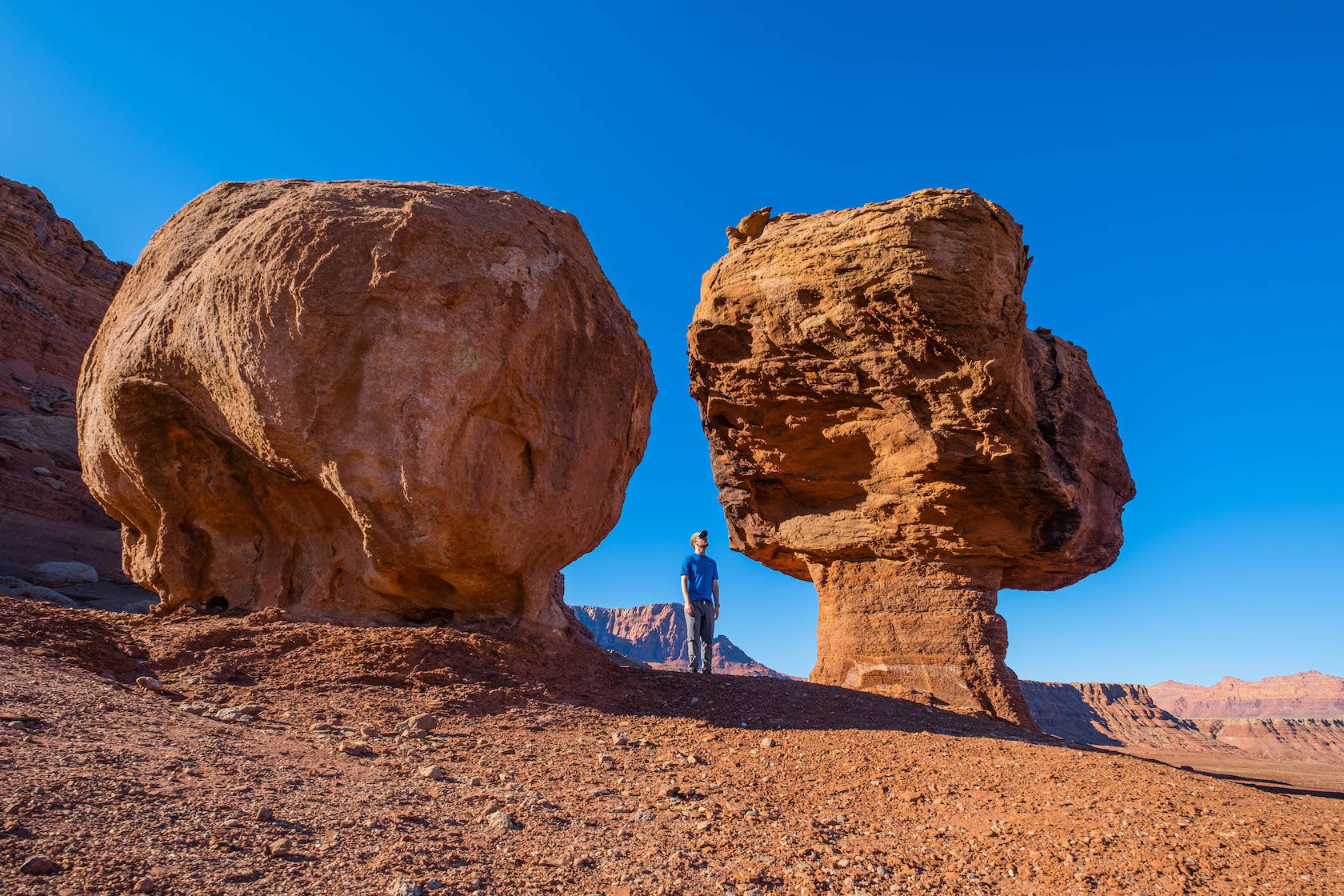
You should know your route in advance and have a basic overview of the topography in the region. Good knowledge of your route direction and notable features in the area will help get you back on the trail or prevent you from getting lost altogether.
As suggested above, this plays along with prior knowledge of your route and water sources before hitting the trail. Good knowledge of your route will help mitigate any potential risks and hazards.
Before you head out for your hike in the desert, it would be a good idea to brush on the symptoms and signs of a heat stroke.
Nutrition is Important

Your nutritional plan is also important as you’ll want a good strategy to fuel your body. Knowing your distance and elevation can give you an idea of how many calories you’ll burn.
Hiking in the desert can burn many calories, 400-600 per hour, so fueling your body with calorie-rich sources will keep you from crashing. Try dried fruits, jerky, crackers, nuts, candy, and protein bars as snacks — be mindful of chocolate as it can turn into a mess in the heat.
Salty snacks are critical, too, when you’re sweating a lot. Keeping up with snacking throughout the day will help replenish the electrolytes you lose through sweat.
Use Sunscreen

Sunscreen is your best friend! Use it first thing in the morning so that it has been applied 30 minutes before sun exposure. Then carry a small tube or tub with you on the trail and reapply throughout the day. We’ve used this mineral-based sunscreen that comes in a convenient travel tin.
Cover Up Too!

In addition to sunscreen, we like to wear loose long sleeve shirts and pants. There are several hiking clothes that are very cool and offer great UPF protection. It’s all personal preference, but I’m not big on pants, so I’ll wear shorts, a long sleeve shirt, and a buff around my neck to keep my neck from getting burnt.
The key is to be mindful of the sun angle, exposure, and any sensations on your skin. If you’re starting to feel hot in a particular area, it’s probably time to stop and use more sunblock. We have a post on our favorite men’s hiking clothes and women’s hiking clothes that are extremely helpful!
Carry an Emergency Kit

Anyone who spends much time outdoors likely has some sort of kit. An emergency kit is a bit more of a first aid kit as it can assist you if anything truly goes wrong and you are in life-threatening circumstances.
A good habit to approach the outdoors is always being prepared to spend the night. This doesn’t mean heading out with a sleeping bag and tent for day hikes. Instead, it’s a good idea to carry extra layers, food, an emergency blanket, light, and a fire starter. This is really important for longer day hikes and areas with few visitors.
I have the following in our emergency kit. I do not throw whole bags or bottles in our kit; when I say Advil or Benadryl, it’s quite literally two or three pills. The goal is to keep the kit as light as possible while carrying everything you could need.
- Garmin InReach
- Emergency blanket
- Flashlight
- Multitool (with tweezers)
- Water tablets
- Strips of duct tape
- Bandages
- Butterfly strips
- Gauze
- Cleansing pads
- Antibiotic ointment
- Needle and fishing line
- Two protein bars
- Firestarter and lighter
- Benadryl
- Aspirin/Ibuprofen
- Pepto Bismol Tablets
Mind The Cacti
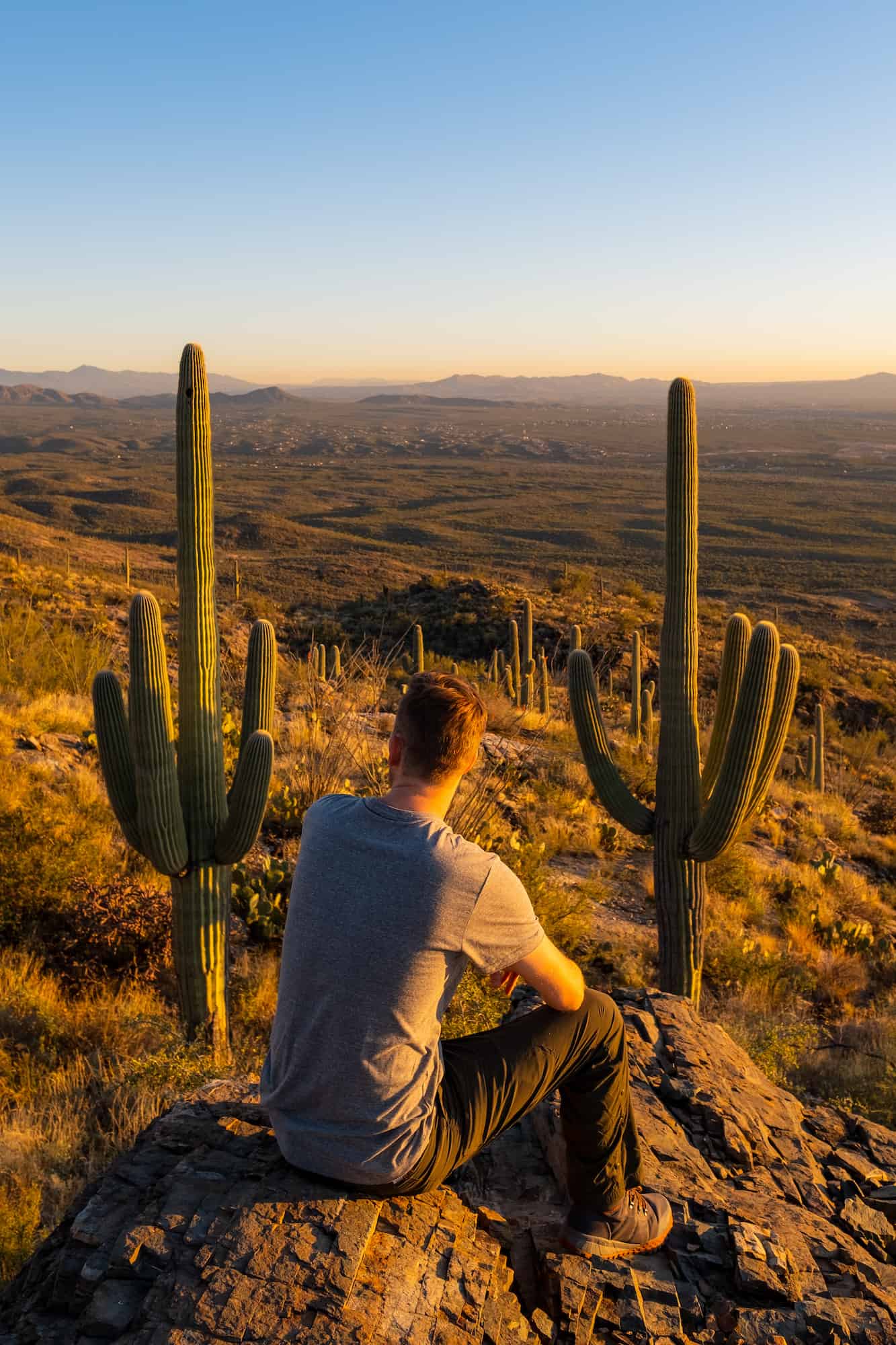
Cacti are both a fascinating facet of deserts and a potential hazard. It only takes one brush with a cactus to leave a hiker with instant regret. While the spines of most cacti do not have any liquid irritants or causes for immediate medical treatment, they can be very painful.
The best way to treat a brush with cacti is to use a tweezer or a multitool to remove the spines. It is one of the many reasons why I always carry a multitool with me when hiking. Grasp the spine as close to the skin as possible to avoid breaking and pull out firmly.
Some cacti have small, densely packed spines that can leave dozens of spines on the skin. A magnifying glass and tweezers can be used to remove these spines, but the most effective and easiest way is to use duct tape.
Prevention is always best to wear closed-toe shoes and be mindful of where you step on the trail. It’s better to move a little slower rather than stop and remove cacti spines.
Be Mindful Of Weather and Flash Floods
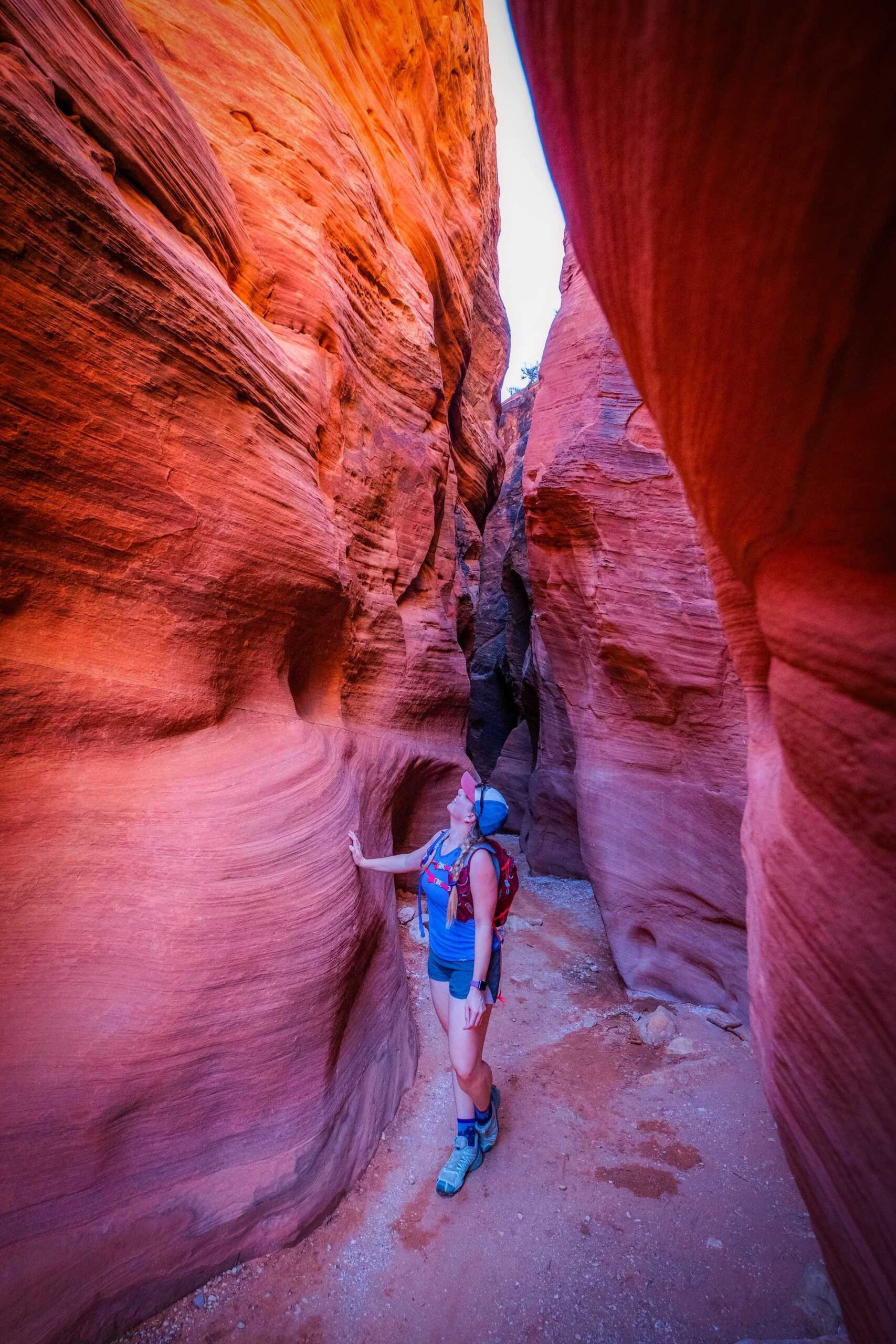
You should prepare for plenty of sun exposure and intense heat in the desert, but you should also be prepared for flash floods. Many deserts experience a monsoon season when thunderstorms move across a region, dumping lots of water in a short period of time. With the arid conditions, open low-lying areas and slot canyons can turn into dangerous flood zones.
Always be aware of the weather forecast in the region and identify any potential flood areas on your hike. If storms appear in the area, be prepared to abandon your hike and plan if conditions appear to deteriorate. Flash floods can be life-threatening and should be treated with respect.
This weather can also bring wild temperature swings, highlighting the importance of carrying wet weather gear and something warm to wear. Monsoon season, in general, runs from spring to summer.
Carry a Flashlight
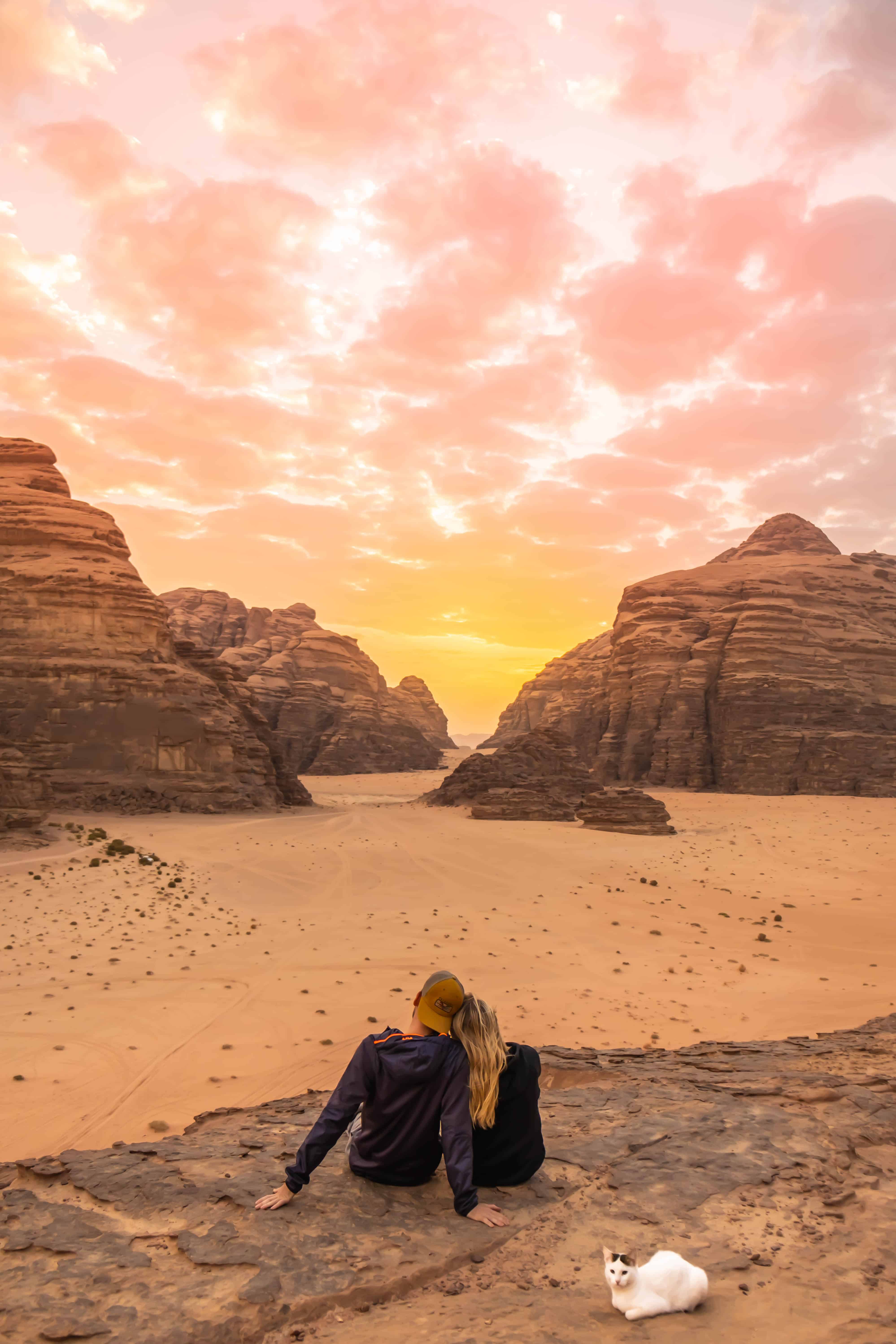
If you’re starting early or ending late, come prepared with a flashlight or headlamp. Hiking in the desert at night can be very dark, so if you’re running late or taking advantage of the cooler temps, it helps to see where you’re heading.
Have a Water Filter Backup

Water is life in the desert. If you’re on a day hike, it’s a good idea to carry a lightweight filter for emergencies or if you run out of water. If you’re on a backpacking trip, we recommend carrying two or, at the very least, water purification tablets. It’s not too difficult if you’re hiking with a buddy, as everyone can carry a water filter.
Always Pack Layers

The photo above is after a long hike in the desert, and we were enjoying the sunset in Page, Arizona, with our Stanley Iceflow Flip Tumbler. The need for a good down jacket was apparent as soon as the sunset. It gets extremely chilly in the desert at night! Check the weather and be aware of systems in the region that could present challenges.
Always pack enough warm clothes to survive a night out in the desert on a day hike. It may seem counterintuitive to bring a packable down jacket for a hike in the desert heat, but it can be a literal lifesaver once temperatures plummet at night.
Wear Cotton
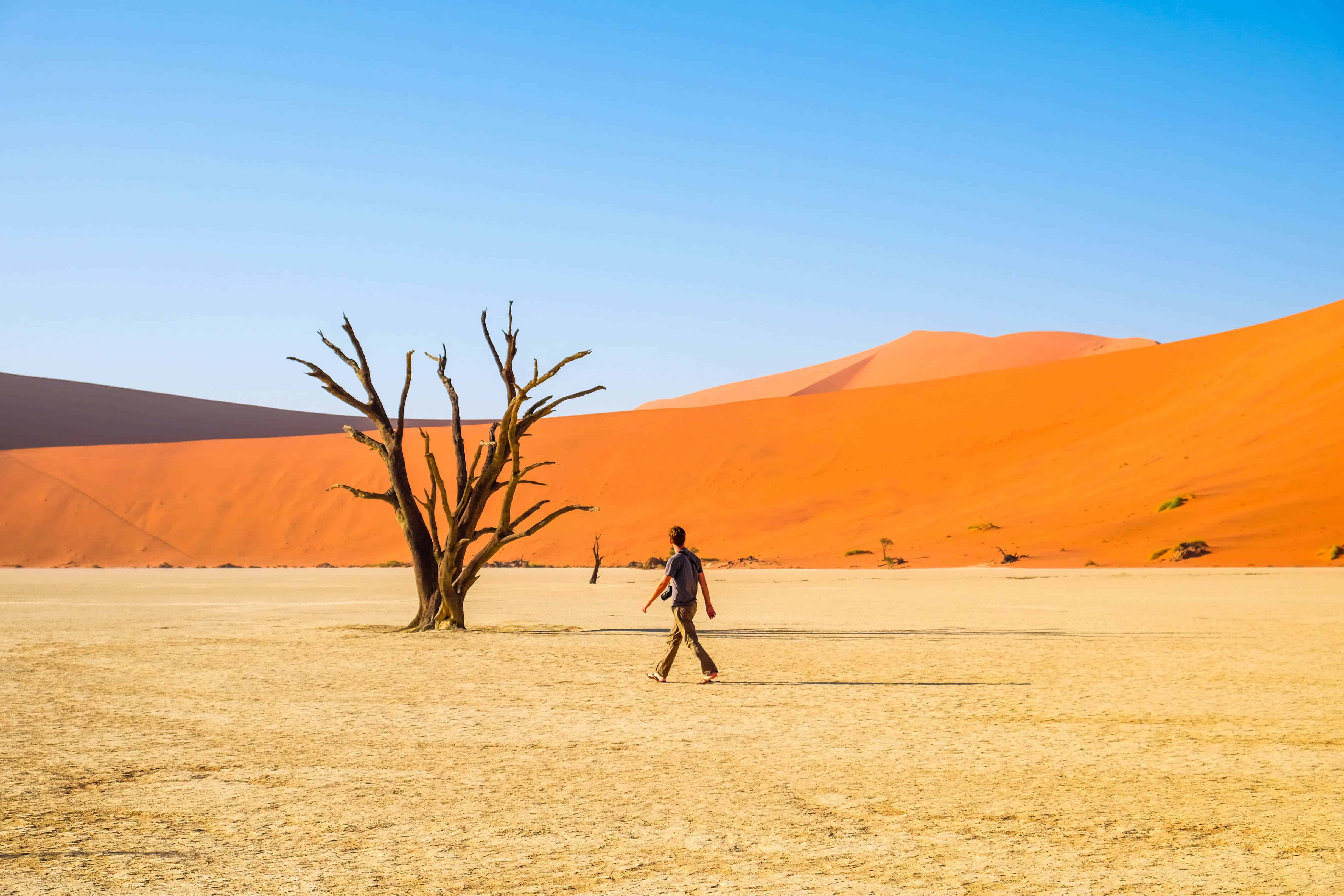
This one is pretty counterintuitive for many who spend their time in the mountains or temperate places. However, cotton is a great tool in the desert as it does a good job of trapping moisture.
We aren’t full converts, as cotton is more likely to cause chafing, but it is certainly worth a try. I wouldn’t recommend cotton for hiking underwear or socks (use merino wool for intimates) as it can cause chafing.
Use the Buddy System

While hiking in Bryce Canyon National Park, we found it easy to get separated when we were off the main tourist trails and on our own. Traveling with a partner who can check for heat-related illness symptoms is always safest. Any big hike or objective is always safest as a team. If you’re hiking with children, ask them regularly how they’re feeling and if they are too hot or tired.
Watch for Wildlife

Keep an eye out for hazardous wildlife in the desert, but not the kind with teeth. A rattlesnake is a classic animal to spot in the American Southwest. This may cause some fear, which is justified as they are venomous snakes. However, it’s unlikely for most hikers to have a deadly encounter with a rattlesnake.
As with all animals, they want their space and are not inherently aggressive. Snakes strike when they feel threatened. This may be as simple as stepping too close, but luckily, rattlesnakes are good at providing advance warning. Your hearing ability is an important safety tool when hiking; never wear headphones.
Snakes are cold-blooded and depend upon external sources to control their body temperature. With this in mind, you’re more likely to find a snake on the trail or a flat ledge enjoying the sun during the morning and evening. While during the hottest part of the day, they will hide in the shade or in the branches of a tree.
Leave Your Itinerary With friends or family

On any hike, it’s a good idea to leave your itinerary with family and friends before you hit the trail. Inform someone of where you are heading in case you were to get lost or injured. If someone knows your general location, it can save your life when first responders come looking for you. Unless you want to end up like Aron Ralston…

